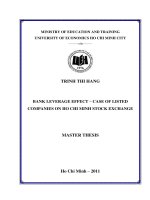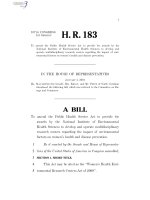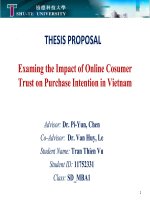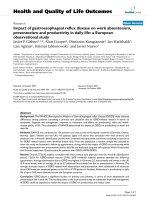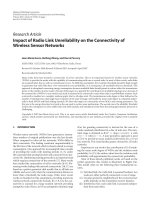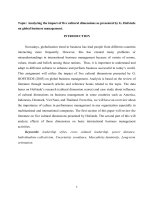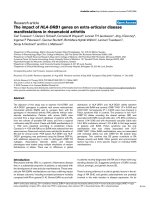impact of listed companies’ attributes on information disclosure level and its consequences
Bạn đang xem bản rút gọn của tài liệu. Xem và tải ngay bản đầy đủ của tài liệu tại đây (295.73 KB, 27 trang )
MINISTRY OF EDUCATION AND TRAINING
NATIONAL ECONOMICS UNIVERSITY
NgO thu giang
IMPACT OF LISTED COMPANIES
’
ATTRIBUTES ON
INFORMATION DISCLOSURE AND ITS CONSEQUENCES
SPECIALTY: FINANCE - BANKING
CODE: 62340201
HANOI, 2014
THE DISSERTATION IS IMPLEMENTED IN
NATIONAL ECONOMICS UNIVERSITY
Advisor:
pROF. DR. cao cU bOi
Appraiser 1:
Appraiser 2:
Appraiser 3:
The dissertation is defended in Examination Committee
in National Economics University, Hanoi
at on 2014.
Be referred in:
National Library of Vietnam
Library of National Economics University
1
INTRODUCTION
Research idea
For efficient operation of a stock market, the investors need adequate
information for their investment decision making. Unsystematic information
(market’s parties are not provided information inadequately) has negative
impact on operation of the financial market.
Vietnam stock exchange (VSE) has been operated since the year 2000 in
a developing economy. With more than ten years of development, Vietnam
stock exchange is under stable operation with participation of organizations and
basic financial instruments as stocks and bonds. However, in recent years, there
are several constraints which prevent efficient operation of VSE such as:
“following behavior”, “internal trading”, “rumor – based trading”, etc.
Facing with above constraints, the dissertation is focusing on studding
“impact of the listed company’s attributes to its information disclosure (ID) in
Vietnam Stock Exchange and consequences to Vietnam Stock Exchange and the
listed company”.
Research objective
Managerial questions of VSE’s governmental organization and managers
of listed companies is how to improve efficiency of market operation through
transference of disclosed information and its benefit to listed companies and
trading transactions in the VSE. To answer the question, VSE’s governor and
listed companies’ managers need to understand comprehensively ID,
measurements of ID level, factors impacting on ID and trading results of listed
companies in VSE.
Research subject and scope
Research Subject of the dissertation is ID of listed companies in Vietnam
Stock Exchange. The research period is from the year 2011 up to present.
Research Sample is a group of listed companies which have been selected
by random method in order to ensure representativeness of the sample in VSE.
Research Questions
Particular research questions are presented as follows:
• Which factors/ measurements can be used to evaluate ID level of listed
companies in VSE?
2
• How do attributes of listed companies in VSE impact on ID level in
general or ID level of each type of disclosed information in VSE?
• What are variables and measurements to be used for measuring
consequences of ID level on listed companies and trading transactions of their
listed stocks in VSE?
Research Contributions
* Theoretical contributions:
The dissertation has generalized a complete theory about ID of listed
companies in stock exchange. The dissertation also developed measurement
criteria of ID; generalized, modified and supplemented listed companies’
attributes; and studied impact of the attributes to ID; and its consequences on
the stock exchange and listed companies. The dissertation has developed a
research model with research hypotheses with application of quantitative
research methodology to test relations among variables of the model.
Particularly, ID has been measured in three (3) aspects: informativeness;
precision and understandability; and update of listed information while the
previous researches have focused mainly on informativeness of disclosed
information.
Regarding to listed companies’ attributes impacting on ID, the
dissertation has evaluated five categories of attributes: (1) Industry; (2)
Ownership: except “foreign ownership”; the dissertation supplemented “state
ownership”; and “relationship between state ownership and institutional
ownership”; (3) Corporate governance: the dissertation modified concept of
“independence” by defining another measurement for the factor as
“Management board’s member cum Director board’s member”; (4) business
performance: the dissertation consider money flow as supplemental
measurement; (5) listing status: the dissertation modified measurement of the
company scale to capitalized value and supplemented “listing organization”
variable.
Regarding to consequences of ID, the dissertation has not only considered
impact of ID to cost of owner equity but also evaluated consequences of general
ID and ID of each information group to oscillation of stock price. At present,
there is no research considering macro and micro impact of ID on the stock
price as proposed in the dissertation.
* Empirical contributions
3
The previous researches implemented mainly in developed countries
or/and in stock exchanges which are developed and have large scale.
Implementing research in VSE is an empirical contribution of the dissertation.
The achieved results have reflected new findings of ID of listed companies in
VSE, as details:
(1) Actual performance of ID by listed companies
(2) Constructive impacts and destructive impacts of listed companies’
attributes on ID of listed companies
(3) Constructive consequences of ID on the cost of owner equity and
oscillation of stock price in VSE
Coping with above actual conditions, the dissertation has developed
recommendations to (1) State managerial organizations to improve contents,
procedures regulated in managerial regulation on ID of listed companies; (2)
Listed companies to improve perception and define key information to
investors; and (3) research direction to be implemented in the future about ID of
listed companies in VSE.
CHAPTER 1
LITERATURE REVIEW AND THEORETICAL FRAMEWORK
1.1 Literature review
1.1.1 Foreign researches
ID of listed companies has been researched more than 10 years in
countries over the world. Foreign researches have focused on three main issues
of ID as following:
• Disclosure of Information: regulated ID and voluntary ID
• Explanation of factors impacting on ID of listed companies
• Impact of ID: direct impact of ID on information users and, indirect impact
on ID on SE.
1.1.1.1 Disclosed information
Information index in initial researches has been constructed for
information disclosed as regulated. Coping with development of SE,
researchers also have found out disclosure tendency of listed companies who
disclosed not only mandatory information but also disclosed voluntarily other
information due to the listed companies have been willing to get attention of
stakeholders.
4
Following the demand of information users, researches have stated to
build up a new information index which includes mandatory information
and voluntary information needed by users and financial analyzers.
1.1.1.2 Factors impacting on ID
Evaluating factors impacting on ID, many researches have implemented
to evaluate impact of listed companies’ attributes on ID such as ownership
structure, international listing, chartered capital, business field, company scale,
capital structure, and business performance, independence between
management board and director’s board; characteristics of members in
director’s board. The researches have applied multi variables regression and
liner regression to illustrate relationship between the factors and ID level.
1.1.1.3 Consequences of ID
The third aspect considered in the research on ID is consequences of ID to
investors in term of transaction performance in SE and to the listed companies.
The researches have measured impact of ID on price oscillation in SE, to
cost of capital, liquidity and value of listed companies. The result shows that
there is a significant relation between ID and cost of capital, and with liquidity
of listed stocks.
1.1.2 Domestic researches
Most of the researches which have been implemented in Vietnam, study
indirectly about ID, including research on corporate governance by World Bank
in 2006, supervision of trading transaction by Le Trung Thanh in 2010; State
governance with listed companies in Vietnam Stock Exchange by Vu Thi Thu
Nga. 2011. The researches have concluded that Vietnam lacks a efficient
management mechanism on quality of disclosed information or the SE
responded very slowly with information disclosure, information is disclosed
delayed and inadequately than as regulated.
Researches focus directly on ID is research of Kelly Anh Vu,2011; and
Ta Quang Binh in 2012 who has studied about impact of independent Director
Board, ownership structure on voluntary ID, gap between information demand
of financial analysts and viewpoints of financial manager of listed companies
about voluntary ID in the annual reports, factors creating the gap and its
consequences on stock price in the market and cost of capital of listed
companies in the year 2009 and 2010.
5
1.2 Information Disclosure and its roles in listed companies
1.2.1 Information Disclosure
In the stock exchange market (SE), information disclosure (ID) is
considered as information transmission between listed companies and their
stakeholders in the SE
1.2.2 Roles of ID in listed companies
ID is considered as an efficient method to minimize and solve
unsystematic information issue and agent problem.
1.3 Government policy in ID management
1.3.1 ID management following listing registration mechanism
(1) Mandatory ID policy
Purpose of the policy is focusing on solving information unsystematics.
Following the policy, the listed companies should disclose information which is
regulated in the regulation.
(2) Voluntary ID policy
The policy has been applied popularly in the early development stage of
financial market of which scale and development level are very small and low.
The purpose of the policy is focusing on solving agency problem, coping with
exposure demand and prestige development of listed companies in stock
market; and creating competitiveness in the stock market.
(3) Mixing ID policy
To overcome disadvantage of mandatory ID policy and voluntary ID
policy, and cope with high development of perception and scale of the stock
market, mixing ID policy is formed with participation and mutually supporting
from above policies.
1.3.2 ID management following voluntary listing with full disclosure
When the joint stock companies disclose fully information, the companies
will be listed in the stock market. The purpose of the policy is constructing
transparency environment of ID.
1.4 ID Strategy
ID strategies applied in the listed companies are categorized as active
strategy and passive strategy. Active strategy satisfies information demand of
user unlimitedly and timely while passive strategy just discloses mandatory
information limitedly.
6
1.5 ID components
ID components are information to be disclosed, information disclosure
channel and disclosure time.
1.5.1 Disclosed information
Making decision relating to ID, listed companies have to consider and
select information which will be disclosure. There are two information group
under consideration: (1) mandatory disclosure (periodical disclosure; unusual
disclosure, disclosure under request), and (2) voluntary disclosure.
1.5.2 Disclosure time
Disclosure time is transmission time and appearance time of information
the SE.
1.5.3 Disclosure channel
Disclosure channels which are apply to transmits information are direct
communication between the management board and investors; road show, press
conference, telecom conference, newspaper, internet and brochure, flyer.
1.6 ID level
To evaluating ID, previous researches developed different viewpoints and
criteria’s for measuring ID.
1.6.1 “Transparency” viewpoint
Transparency is evaluated basing on information items disclosed by listed
company in comparison with information needed by investor. The measurement
only ensures disclosure of information items, not meaning adequateness of
information disclosed.
1.6.2 “Quality” viewpoint
Information quality is evaluated with six aspects as informativeness,
relevance, precision, rarity, frequency, and unexpectedness; or briefly evaluated
with three aspects as: relevance, reliability, and understandability. A
disadvantage of the method is feasibility of measuring reliability aspect.
1.6.3 “Efficiency” viewpoint
Information disclosure is evaluated as efficient if the information is
disclosed adequately, accurately and updated. The viewpoint considered
“update” aspect as a supplement aspect for evaluating ID which is not reflected
in the previous viewpoints.
7
1.6.4 Conclusion
It is necessary to evaluate ID level basing on typical characteristics of
information, including adequateness, precisiveness and update. Hence, the
dissertation evaluates ID level with three aspects (1) informativeness, (2)
precision and understandability; and (3) update.
1.7 Factors impacting on ID
Considering factors impacting on ID, the dissertation has focused on
impact of industrial environment and internal environment of listed companies.
1.7.1 Business industry
Factor considered in industrial environment of the listed company is
business industry. Relation between the business industry and ID is not
consistent in various stock exchanges.
1.7.2 Ownership
Structure of ownership is considered as ownership of managers,
management board, foreign investors, local investor, family members and
government.
1.7.3 Corporate Governance
Considering corporate governance, the researches considered agency
problem between management board and director board which are measured by
circumstance of management board’s member cum CEO and percentage of
Management board’s members participating in Director Board.
1.7.4 Business scale
There is a relationship between business scale and ID. The business scale
is measured by capitalized value of listed companies in the stock market.
1.7.5 Business performance
Profitable ratios (ROA, ROE and ROS) are used popularly. However,
ROS is only suitably using for evaluating companies which are in same
industry.
1.7.6 Listing status
Listing status includes listing market; listing time and listing value.
1.7.7 Quality of independent auditor
Role of independent auditor is checking reliability of ID. However,
impact of independent auditor’s quality on ID is not remarkable.
8
1.7.8 Conclusion
After evaluating feasibility of applying above attributes of listed company
in the research, the dissertation has selected following attribute categories:
(1) Industry: Industry registered in business license of listed companies
(2) Ownership: structure of liability and owner equity, state ownership;
foreign ownership, and institutional ownership
(3) Corporate governance: Management board’s member cum CEO;
percentage of Management board’s members in director board.
(4) Business performance: general business efficiency: ROA and net cash
flow to revenue ratio; and owner equity efficiency: ROE, net cash flow to
net income; and growth rate of net income
(5) Listing status: listing year; listing market; and capitalized value per share
1.8 Consequences of ID
Market operation is evaluated as perfect when (1) price and trading
volume changes in coping with information disclosed in the market; (2) high
liquidity; (3) minimizing transaction cost.
In the viewpoint of listed companies, market operation is evaluated as
good when it can minimize cost of owner equity; improve market value of the
firm. However, strength of impact of ID is relating to the market development
level.
CHAPTER 2
ID IN VIETNAM STOCK EXCHANGE
2.1. Viet Nam stock exchange
Development history of Vietnam stock exchange (VSE) is divided into
two stages. Stage 1: preparation for opening official stock exchange (1990s).
Stage 2: operation stage of VSE, starting from the year 2000. With more than 10
years of improvement, starting with 5 stocks, up to the end of 2013, the number
of listed stocks is up to 983 stocks.
2.2. Government management in ID of listed companies in VSE
2.2.1.Government policy in managing ID of listed companies in VSE
Market managerial organization decided to select full disclosure policy in
replacement of mandatory ID policy. Purpose of government management is
not only improving transparency of market, but also building up concrete base
9
for VSE to apply full disclosure – listing mechanism in replacing the present
listing registration mechanism.
2.2.2. Legal documents on ID of listed companies in VSE
2.3. Particular regulations on ID of listed companies in VSE
2.3.1. Information disclosed
According to circular 09/2010/TT-BTC relating to ID in VSE, listed
companies are regulated to disclose following information:
Periodical disclosure:
Financial statements, annual report (26 information items)
Unusual and/or requested disclosure: 7 information items
After one year of applying circular 09/2010, circular 52/2012/TT-BTC is
issued to regulate an adequate information index with 21 information items
following full disclosure policy.
Periodical disclosure:
Financial statements, annual report (26 information items) and managerial
reports
Unusual and/or requested disclosure: 19 information items
2.3.2. Disclosure time
Regarding to periodical reports, disclosure time regulated in circular
51/2012 is shorten about 10 days in comparison with time mentioned in circular
09/2010. Regarding to unusual and/or requested disclosure such as listing
information, trading, supervising; resolution of shareholder meeting; resolution
of management board, etc; disclosure time is within 24 hours.
2.3.3. Disclosure channel
Information is disclosed through 4 channels: (1) annual report, website
and other reports of listed companies; (2) ID instruments of State Security
Commission (SSC), and (3) ID instruments of Stock exchanges and (4) other
mass Medias.
2.4. ID violation of listed companies in VSE
Violation in ID is the most popular violation in security field. The
following violation items are in order of popular status:
ID: violation is occurred due to submission delay or misleading in
disclosing of financial reports; annual reports, managerial reports, resolutions of
shareholders’ meeting and management board; change of personnel; trading of
10
stock treasury; capital using report; CV of key persons and unusual activities
inside the listed companies.
Disclosure channel: website of listed companies has not adequate
information and not updated.
2.5. Comparison of ID of listed companies in Vietnam and foreign
countries
Depending on scale and development of stock market, market managerial
organization has to define a suitable ID management of the market.
2.5.1.ID of foreign listed companies in S&P researches
According to researches done by Standards & Poor’s; transparency of ID
is evaluated basing on detail level of three information categories: (1) Owner
equity’s structure and investors’ right; (2) financial statements and business
information; (3) ownership structure and benefits of managers. The achieved
results show that transparency of ID in financial market of developed countries
such as Latin-American countries; and Asia developed countries are very low;
disclosed information is mainly are “financial statements and business
information”
2.5.2.ID of listed companies in Vietnam following S&P research methodology
Transparency of ID by listed companies in VSE is as good as ID of listed
companies in developed countries such as Europe, Japan, etc. However, quality
and adequacy of information items in each information category are very low.
CHAPTER 3
RESEARCH METHODOLOGY
3.1. Model and research hypotheses
Basing on literature review and “undiscovered field” in the ID researches;
the dissertation has built up a research model as reflected in following figure.
11
Figure 3-1 Research model
Hypotheses on relationship between listed companies’ attributes and ID;
and impact of ID on trading result of stock and listed companies as developed as
follows:
(1) Testing suitability of proposed model
H1. Listed companies’ attributes have significant impact on ID level of
listed companies in stock exchange
(2) Testing impact of each attribute category on ID level
H2. Listed companies in different industries have different impact on ID
level
H3. The higher percentage of foreign ownership and institutional
ownership, the higher ID level
H4. Management board’s member cum CEO; the higher percentage of
management board’s members in director board; the higher ID level
H5. The better business performance, the higher ID level
H6. Listed companies in different stock exchanges have different impact
on ID level. The longer listing time, larger capitalized value, the higher ID level
(3) Testing consequences of ID level on stock exchange and listed
companies
H7. The higher ID level, the lower cost of equity
H8. The higher ID level, the lower stock price oscillates
ATTRIBUTES OF
LISTED COMPANY
INFORMATION
DISCLOSURE
STOCK EXCHANGE
CÔNG T
LISTED COMPANY
Industry
Equity ownership
Business performance
Corporate governance
Listing status
INFORMATIVENESS
UPDATE
PRECISION AND
UNDERSTANDABILITY
Oscillation of stock
price
Cost of
Owner equity
12
3.3. Research sample
Research subject of the dissertation is ID of listed companies in VSE.
Research sample includes 30 listed companies which have been listed before 1st
January 2010; and selected randomly. The research period is 3 years starting
from 2011 to the end of 2013?
3.4. Factors, variables and measurements
As presented in the above contents, the research model of the dissertation
considered 3 factor categories. Variables and their measurements are shown in
following table.
Table 3-2 Factors, variables and measurements
Factors Variables
Variable
concepts
Measurements
Data sources
Listed companies’ attributes
1.1
Industry Industry group Industry classification
criteria VSI 2007 is applied
for both listed companies in
HSX and HNX
Information of
listed companies
which are
disclosed in
website of the
stock exchanges
1.2
Equity
ownership
Ownership
structure of
equity owners
Owner equity to total capital
ratio
State ownership
Institutional ownership
Foreign ownership
Ownership
structure (in
website of listed
companies and in
website stox.vn)
1.3
Corporate
governance
Independence
and number of
management
board’s
member
participating
director board
(cum status)
“Independence”: scoring 1
or 0 with listed companies
which have management
b
oard’s member cum CEO;
or non, respectively
“cum- status”: number of
management board’s
member participating
director board
Key personnel
(in website of
listed companies
and in website
stox.vn)
13
1.4
Business
performance
Revenue, net
income, asset,
liability and
owner equity
and cash flow
Business performance in
previous year and present
year
- ROA, ROE, cash flow to
net income ratio; cash flow
to revenue ratio and growth
rate of net income.
Annual reports
and financial
statements
1.5
Listing
status
Listing time,
stock exchange
to be listed and
capitalized
value
- Listing time
- stock exchange (HNX or
HSX)
- growth rate of capitalized
value
Listing
information in
stock exchanges
14
Information disclosure
Disclosed
information
items
During
research
period: 3
years starting
from 2011 to
the end of
2013
Informativenesss:
information items
are disclosed
periodically and
unusually
requested.
Scoring: 1 or 0
respectively with
appearance or non-
appearance of
information as regulated.
- Scoring of annual
report: checking
information items
disclosed actually in the
checklist of regulated
information items
- Scoring of other
periodical reports
(managerial reports and
financial reports):
checking reports
disclosed actually in the
checklist of regulated
reports
- Scoring of unusual
information and
disclosure requested
information.
Periodical
reports and
Information
items disclosed
in Stock
exchanges’
website
Precision and
understandability:
presentation of
disclosed
information (figures
and explanation)
- Percentage of
presentation by figures
and presentation by
wording in annual reports
Annual reports
disclosed in the
website of stock
exchanges
15
Update Scoring: 1 if the
information item is
disclosed before or right
at regulated time; or right
after its generating time.
Other cases will be scored
as 0.
Actual
disclosure time,
regulated
disclosure time;
information
generating time
Consequences of ID
3.1 Consequences
on oscillation
of stock price
Oscillation of stock
price during and
after information
disclosure
Stock price oscillation
during research period.
Stock price oscillation
when ID occurs.
CAR (cumulative
abnormal returns) for the
3 day period starting from
disclosure date.
Actual stock
price before,
during and
after disclosing
information
which can be
collected in
stock
exchanges
3.2 Consequences
on cost of
owner equity
Beta of stock during
research period
Beta is defined by
regression method
applied for stock rate of
return and market rate of
return.
The defined betas will be
rechecked with betas
defined by other sources
(stox.vn; vietstocks.vn)
Daily trading
data of stocks
disclosed in
stock exchanges
and securities
companies
(fpts.vn)
CHAPTER 4
THE MODEL TESTING
16
4.1. Variables’ measurement
4.1.1. Listed companies attribute
4.1.1.1. Industry
Industry classification criteria VSIC 2007 are approved by SSC for
applying in HSX. In order to standardize sample, the dissertation also applied
the criteria for industry classifying in HNX.
Following the criteria, the result shows that industry distribution is not
equally among industries. The industry including largest number of listed
companies is class C. “Manufacture and processing” with percentage of 34.6%
and 41.8%; and class F. “Construction” with percentage of 34.6% and 41.8%
respectively in HNX and HSX.
4.1.1.2. Ownership
Attributes of ownership of listed companies are as follows: averaged
percentage of owner equity in total capital is about 47.57%. State ownership is
accounted averagely is 27.80%. Much lower than state ownership, foreign
ownership is only accounted for 12.40% in average. The largest institutional
investor is state.
4.1.1.3. Corporate governance
Statistic results show that, more than 75% of listed companies in the
sample have the management board’s member as CEO. When calculating
percentage of management board’s members participating on director board,
average figure is 52.37% and increased continuously from the year 2011 as
41.47%.
4.1.1.4. Business performance
In research period, return on asset of previous year and present year are
respectively as 6.68% and 5.66%. Remarkably, percentage of net cash flow to
revenue of listed companies in research period is quite low. Return on equity of
previous year and present year are respectively as 15.8% and 12.5%. During the
period, listed companies faced decrease of profitability.
4.1.1.5. Listing status
List companies in the sample have relatively long listing period. Listing
period is 3.76 years in average. Most of companies in the sample are listed in
HSX. Researched companies have positive growth rate of capitalized value as
2.45 in average.
17
4.1.2 ID level
4.1.2.1. Informativeness
Regarding disclosed information in annual reports, information disclosed
in the year 2010 -2011; and 2012 are accounted respectively for 62.88%;
83.59% of regulated information volume. Among information items from A to
G group, information in group A “history of listed company” and group D
“financial statements” are disclosed as the most adequately. However,
information relating to prosperity and future plan; benefits of director board;
chief accountant and labor are rarely or not disclosed.
Disclosure of unusual or requested information
Unusual or requested information are disclosed more abundantly. In the
year 2011, volume of unusual or requested information is not large, only 3
information categories have been usually disclosed as unusual events; public
trading offers and large shareholders’ trading. From the end of 2012 to 2013, the
unusual or requested information is disclosed abundantly with information
related to explanation, resolution of management board, changes on corporate
governance.
Total volume of disclosed information
Total volume of disclosed information among observations is quite
different. Total volume in average is about 30 information items; however,
standard deviation is about 17 information items. In the sample, more than 50%
listed companies has information volume is smaller than average information
volume of the sample.
Comparison of informativeness in different stock exchanges
Testing results show that ID in two stock exchanges is significantly
different with approximately confident interval of 100%. The result also shows
that informativeness of listed companies in HSX is higher, and more
homogenous than in HNX.
4.1.2.2. Update
In general, listed companies complied seriously regulation on disclosure
time. The most updated submit ion time is for periodic reports. Disclosure time
of unusual or requested information is also complied seriously.
Disclosure of periodical information, statistic results show that annual
reports are the most updated reports, and next updated reports are managerial
reports. Disclosure of financial statement is normally delayed. Regarding
18
disclosure of unusual or requested information, information items which are
always disclosure on time are listing information, trading information, public
offers and unusual information. Sensitive information relating to managerial
issues, explanation of difference in business performance in different period;
business activities are usually disclosed lately.
Comparison of time compliance in different stock exchanges: regarding
update of all disclosed information and periodical information, there is not
concrete base to confirm that existing difference in ID update of listed
companies in two stock exchanges. However, with unusual and requested
information, listed companies in HSX complied disclosure time much better
than in HNX.
4.1.2.3. Precision and understandability
Precision and understandability of annual reports in 2010 and 2011 is not
good with low rate of 17.13% in average of figure and tables shown on the
reports. Annual reports in 2012 has presented much better. Among information
items presented in the reports, the part which has many tables and figures are
ownership part while the business information part relating to business
performance in last year and plan in the next year has a small percentage of
figure and tables presented.
4.1.2.4. Relationship between measurements of ID level
Statistic data shows significantly positive relationship between
informativeness and update of ID which means that the more information the
company disclosure, the more update information they provide.
4.1.3. Consequences of ID
4.1.3.1. Oscillation of stock trading
Average of stock rate of return in the sample is about 3%, with standard
deviation of 0.875%. Hence, listed companies in the sample have relatively
homogenous oscillation of stock rate of return.
4.1.3.2. Cost of owner equity
The average beta of listed companies in the sample is 0.8346. It means
that oscillation of stock prices is lower than oscillation of market index.
4.2. Hypotheses’ testing
4.2.1. Correlation matrix of independent variables in the model
Correlation matrix of variables’ measurements shows that most of
independent variables are independent mutually. Dependent measurements are
19
measurements of variable “ownership”, “business performance” and
“capitalized value per share” of “listing status”. Significantly dependent
measurements are converted to new measurements called as “mutually
dependent variables”.
2.2.2. Impact of listed companies’ attributes on ID level
Testing of hypothesis H1 for general ID
Testing result shows that there is a significant impact of listed companies’
attributes on information volume and information update. The result also
reflected stable and suitable of proposed model in VSE.
Testing of hypothesis H1 for periodical ID
Dependent variable in testing are information volume and update of
periodic reports disclosed in the research period. Testing result shows that there
is a significant impact of listed companies’ attributes on periodical ID.
Testing of hypothesis H1 for disclosure of annual report
Testing result shows that there is a significant impact of listed companies’
attributes on information volume in annual report with confidence interval of
90%. However, there is no concrete evidence showing that listed companies’
attributes have significant impact on precision and understandability of the
annual reports.
Testing of hypothesis H1 for disclosure of unusual and requested
information
It is concrete to confirm that there is a significant impact of listed
companies’ attributes on information volume and update of unusual and
requested ID with confidence interval of 100%.
4.2.2.3. Testing of each attribute categories on ID
Hypothesis H2
Variable “Industry” is divided into two sub-variables: group 1, including
companies which are under industry class C “manufacture and processing” and
F. “construction” and group 2, including companies from other industries.
Testing of relationship between “industry” and ID with t-test shows that there is
no different of ID level in different industries, except with measurement of
“informativeness” of general ID.
Hypothesis H3
Testing result shows “ownership” has significant impact on information
volume and information update. The strongest and positive impact on
20
information volume is from “foreign ownership”. “Foreign ownership” and
“state ownership” have opposite impacts on update of ID and overlap each
others.
Regarding periodical ID, there is no concrete evidence to conclude that
ownership has significant impact on this ID. In which, with annual report,
foreign ownership has positive impact on information volume in the report
while only debt to owner equity ratio has significant but negative impact on
update characteristics. The result also reflected that it is not possible to conclude
that ownership has significant relation with “precision and understandability” of
the annual report.
Regarding to unusual and requested ID, ownership has significant impact
on ID level with confident interval of 100%. In which, foreign ownership has
strongest and positive impact while state ownership has negative impact on both
informativeness and update of ID.
Hypothesis H4
Generally, corporate governance has significant impact on ID. The
strongest and positive impacting variable is “independence”, which means that
if a management board’s member takes CEO position, the ID will be
informative and updated. “Percentage of management board’s members
participating on director board” variable has negative impact on informativeness
of unusual and requested ID. Regarding to annual report, only “independence”
has positive impact on informativeness, precision and understandability.
Hypothesis H5
Testing result shows that it is not possible to conclude that business
performance has significant impact on ID of listed companies. Only ROA has
direct and positive impact on informativeness. Regarding to equity efficiency,
testing result shows that ROE only has positive and significant impact on
informativess of general ID, precision and understandability of annual report.
Hypothesis H6
Testing result shows that listing status is one of important variables
impacting on ID. Listing status has positive impact on informativeness and
update of general ID, periodical reports, annual report; and unusual and
requested ID. Precision and understandability of annual reports is not impacted
by listing status. “Capitalized value” measurement only has significantly
positive impact on general ID and unusual and requested ID.
21
4.2.2.4. Comparison of impact of listed companies’ attributes
Regarding to general ID, the variables which have most positive and
strongest impact are ROA and ROE. Foreign ownership has strongest and
positive impact while state ownership has negative and strongest impact on
update of general ID.
Regarding to periodical ID, the variable which has most positive and
strongest impact on informativeness and update is percentage of management
board’s member participating on director board member while the variable
which has negative and strongest impact is “listing stock exchange”.
Regarding to unusual and requested ID, except state ownership, all
variables have positive impact on informativeness and update of ID. The
strongest and positive impacting variable is foreign ownership while the
negative impacting variable is state ownership.
Regarding to annual report, the variable which has strongest and positive
impact on informativeness of annual report is foreign ownership, lower
impacting variables are listing stock exchange, percentage of management
board’s member participating on director board member. The positive
impacting variable which leads to decrease of figure and table percentage in the
report is debt to equity owner ratio.
4.2.3. Consequences of ID
Hypothesis H7
Testing result shows that ID level has significant and negative impact on
beta of listed companies.
Hypothesis H8
ID level has significant and negative impact on oscillation of stock price.
However, in order to understand more clearly about impact of each ID
categories on stock price, the research measures oscillation of stock price under
disclosure of each information categories. The result shows that disclosure of
annual report and financial statements has strongest impact on stock price’s
oscillation. Managerial reports are evaluated as minor reports. Regarding
disclosure of unusual and requested information; information relating to unusual
events and changes of company governance has stronger impact on stock price
than disclosure of large shareholder’s trading.
CHAPTER 5
CONCLUSION AND RECOMMENDATION
22
5.1. Theoretical contributions
The research has generalized ID with ID measurements, impacting
variables of listed companies’ attributes on ID and consequences of ID on listed
companies and listing stock exchange.
5.2. Empirical contributions
The research has described and tested ID of listed companies in VSE. The
result has shown concept of ID, impacting factors and actual consequences
created by ID in VSE. Basing on the result, the dissertation has developed
recommendations to (1) Governmental organization to improve contents,
procedure regulated on ID of listed companies; (2) listed companies to improve
perception and define significant information needed to provide to the investors;
and (3) future research direction about ID of listed companies in VSE.
5.3. Recommendation
5.3.1.To governmental organization
5.3.1.1. Managerial policy on ID of listed companies in VSE:
Full disclosure policy is a concrete base for changing from listing registration
mechanism to full disclosure listing mechanism. The dissertation recommended the
governmental organization to continue following the idea of applying new listing
mechanism and improving legal framework supporting efficiently the mechanism.
5.3.1.2. Legal documents on ID of listed companies in VSE
Disclosed information
Regarding periodical ID, it is necessary to consider supplement of
following contents into present regulations:
About content, it is necessary to clarify more detail information which
should be disclosed in annual report. With managerial reports, it is better to
modify content of the report in order to improve meaning of the report. It is
better to replace “list and trading transactions of shareholder” to “ownership
information”; “other issues” to “business managerial activities of management
board and director board”.
About kinds of report, it is necessary to supplement report on ownership
and sustainability report.
Regarding unusual and requested ID, it is remarkable to (1) modify
following information categories: “trading transaction of large shareholders,
internal shareholders and relatives”: supplement summary of ownership status
after implementing trading activities of large shareholders, internal shareholders
23
and relatives. (2) Supplement following information to the present regulation:
changes in business actives, risk raised when business environment changes.
ID channel
It is necessary to supplement managerial activities on controlling content
and update of information disclosed in listed companies’ websites.
ID process
It is necessary to supplement testing step of information accuracy. Listed
company should form an authorized team with participating of representatives
from management board, director board, supervision team, labor union and
responsible expert from employed independent auditor to take responsibility of
information accuracy and disclosure compliance as regulated.
ID language
It is necessary to supplement English as official language of ID.
ID punishment
Regarding to punishment applied for violation in ID, it is recommended
to apply flexible punishment mechanism. With violation in large stock trading,
relative punishment rate is recommended to apply basing on actual trading
value. With other violation, progressive punishment value is recommended. The
more time of violation occur, the higher punishment value is applied.
5.3.1.4. Regulation on listed companies’ attributes
(1) Industry:
It recommended supplementing description information about industry
and industrially typical - financial ratios which the listed companies should
disclose in their reports.
(2) Ownership
It is necessary to encourage increase of foreign ownership in listed
companies. Due to negative impact of state ownership on ID, the governmental
organization is recommended to consider a reasonable percentage of state
ownership. The dissertation recommended a figure of 25% for state ownership.
(3) Corporate Governance:
It recommended the governmental organization to minimize impact of
“agency problem” by controlling number of management board’s members
participating in director board. According to analysis, the number is not over
than 50% of director board’s members.
(4) Business performance:
